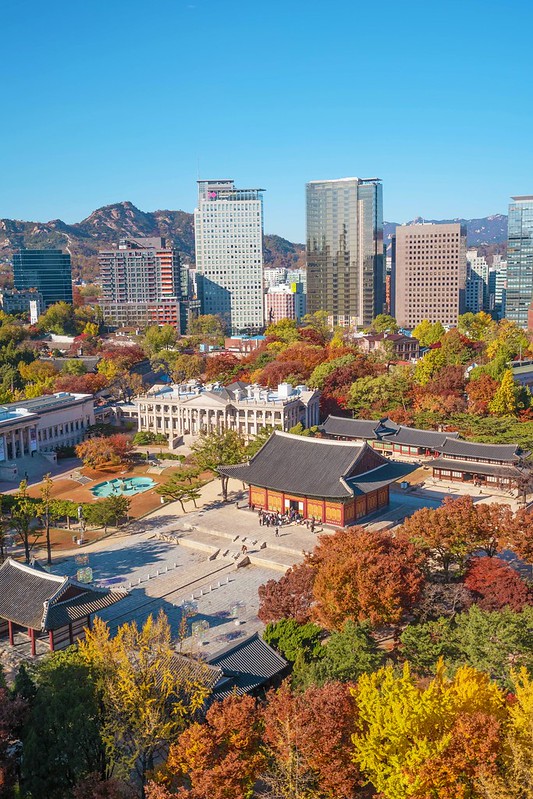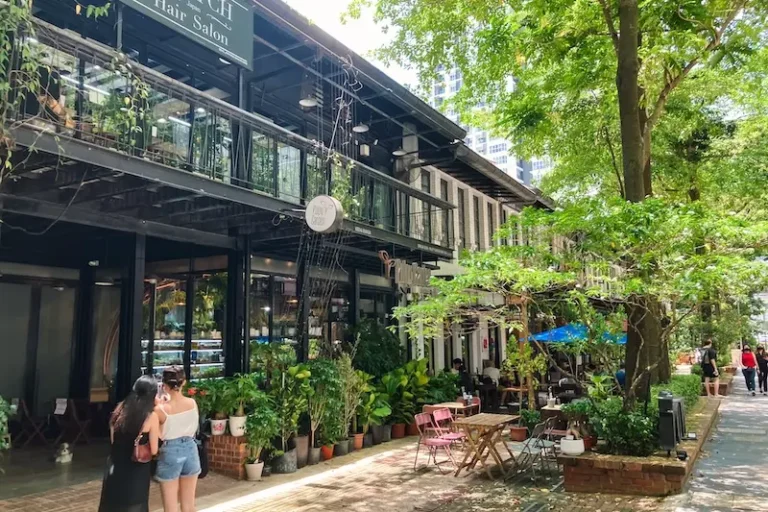GUIDE TO DEOKSUGUNG PALACE IN SEOUL

What to see at Deoksugung Palace in Seoul? Is Deoksugung worth a visit?
Deoksugung is one of five royal palaces located in Seoul. Its name can be translated as the palace of virtuous longevity.
Deoksugung Palace dates back to the 15th century and was used as a residence for the Grand Prince Wolsan, big brother of King Seongjong (1469-1494).
The palace also served as a temporary residence for King Seonjo, back from exile after the end of the Imjin war (1592-1598).
One of the specifics of Deoksugung Palace is that it is the only royal Palace housing both buildings in the traditional Korean style but also buildings in Western architecture.
Key Takeaways from a visit to Deoksugung:
– Deoksugung is unique for its blend of traditional Korean and Western architectural styles.
– The palace has a rich history, having been the residence of various Korean royalties.
– In our opinion, it is most beautiful to visit Deoksugung at night
– Deoksugung is one of the 5 MAIN GRAND PALACES OF SEOUL
In this post, we will tell you all about Deoksugung Palace in Seoul. Enjoy the tour!
Useful information about Deoksugung
How to get there?
Address: 99 Sejong-daero, Jeong-dong, Jung-gu, Seoul, South Korea
By Subway:
As the palace is next to Seoul City Hall on Gwanghwamu, you can simply stop at City Hall Station, via the following 2 lines:
LINE 1, go to exit 1 or 3
LINE 2, go to exit 12
By Bus:
Get off in front City Hall, at the “Deoksugung Palace” or “City Hall Station” stop. If you are already in the city center, you will have the choice between these different bus lines:
- Green line n ° 1711, 7016, 7022
- Blue line n ° 103, 150, 401, 402, 406, 604 or the N16 at night
- Jongno Bus n ° 09 or 11
If you are arriving directly from the airport, you can take bus 6005.
Other Useful Information
- Opening hours: Open from 9 a.m. to 9 p.m. Tuesday to Sunday (last admission at 8 p.m.).Deoksugung Palace is closed every Monday.
- Admission: Adults 800 won / Children 400 won
- Website: http://www.deoksugung.go.kr:8081/
Our recommendations
- If you wear a Hanbok (traditional Korean costume) you can enter for free. You can rent a Hanbok at low price here. Besides giving you free access to all palaces, wearing Hanbok is super fun and will give you plenty of photo opportunities.
- To make the most of these five palaces, the city of Seoul has implemented a pass. This is a small notebook with tear-off coupons. To purchase it, simply go to the cash desk at one of these five locations and request a Combination ticket for palaces. It is 10,000 won (5,000 won for children). Which is cheaper than paying for each visit. This pass is valid for three months.
- We recommend joining a guided walking tour to learn more about the history of Seoul and Deoksugung Palace. You can join here.
Night visit to Deoksugung
As Deoksugung Palace stays open until 9pm, it is best to visit the Palace at night. At least we enjoyed it much more with all the beautiful lights inside the palace and surrounded by the city lights from the surrounding skyscrapers of Seoul.
The contrasts of both, make it a unique sight.
A bit of history about Deoksugung
Deoksugung Palace was built during the reign of King Seongjong in the 15th century, to serve as a residence for his older brother, Prince Wolsan.
In summary, here are the main dates to remember:
Second half of the 15th century: construction of the residence, by King Seongjong for his older brother.
1593: the Japanese invasion puts King Seonjo (1552-1608) into exile, who returns a year later to settle temporarily in Deoksugung Palace, spared by the fires.
1608: Seonjo’s successor, King Gwanghaegun (1575-1641) is crowned in this palace, although the latter is in the process of rehabilitating the Changdeokgung Palace, which will then serve as his residence.
1611: King Gwanghaegun renamed the palace to “Gyeongungung”, giving it the status of royal palace.
1618: King Gwanghaegun takes up residence in the renovated Changdeokgung Palace. Gyeongungung Palace would later be renamed “Seogung” (Western Palace), and would remain an auxiliary royal residence for the next 270 years, playing no significant role until the end of the 19th century.
1897: Emperor Gojong established the Great Han Empire, the first Korean empire, and moved into this palace. Gojong was determined to modernize the country, which explains the presence of Western-style buildings today within Deoksugung Palace itself.
1907: Emperor Gojong comes under pressure from Japan and must abdicate in favor of his son, Sunjung, who will be the last ruler of the country. Emperor Sunjong then gave the palace its current name, Deoksugung, in honor of his father Gojong. The name was intended to wish Gojong a long and prosperous life, as the latter lived at Deoksugung Palace until his death in 1919 at Hamnyeongjeon Hall.
Things to see at Deokusgung in Seoul
1. Daehanmun Gate (main entrance)
While this is the main gate today, it wasn’t always the case. Traditionally, the main gate of palaces in Korea are located in the south when Daehanmun is located east. It became the main gate after the expansion of the road facing it. This is not the only exception as the main gate of Changgyeonggung Palace is also east.
The base and stairs of the gate are now buried underground, after the gate was moved back slightly from its current location, to make room for the expansion of the avenue facing it.
It is also in front of this gate that you can attend the change of the guards ceremony. It takes place every day (except the closing day, Monday) at the following times: 11:00 a.m., 2:00 p.m. and 3:30 p.m.
To access the Palace you can purchase your ticket at the booth right beside Daehanmun Gate.
2. Gwangmyeongmun Gate
Gwangmyeongmun Gate looks very lonely in the middle of a large courtyard. The reason being that the latter was originally the door leading to the Emperor’s residence (Hamnyeongjeon Hall)
However, the Gwangmyeongmun Gate was moved by the Japanese in 1938 near the Seokjojeon Building, and then refurbished with the addition of the West Wing and the fountain. While the gate has recently returned to its original place, the walls and the rest of the configuration of this area of the palace have not, leaving this gate without anything around…
3. Hamnyeongjeon Residence and Deokhongjeon Hall
Hamnyeongjeon served as Emperor Gojong’s bedroom although the building also housed the Empress under the same roof. The right wing was the Emperor’s quarters and the Empress slept in the left wing. It is also in this building that the emperor Gojong took his last breath.
Deokhongjeon Hall is the secondary building adjoining the Emperor’s quarters. It is one of the most recent constructions dating from 1911. This is why, Deoksugung is very different to the other Palaces, as it has more modern buildings contrasting with the traditional part of the Palace built in the 15th century.
The Deokhongjeon Hall is a bit special because it is square in shape, against the usually rectangular halls in Korean tradition. Deokhongjeon was made to receive ambassadors, high dignitaries and to conduct the daily business of the government.
4. Jeonggwanheon and Deoksugung Gardens
Just behind Hamnyeongjeon and Deokhongjeon is a lovely terraced garden, dominated at the top by a small hall, Jeonggwanheon. The name could be translated as “the place to observe the garden in silence”. This is our favorite part of Deoksugung Palace.
Built in 1900, Jeonggwanheon was the first example of European architecture integrated into a royal palace. Emperor Gojong liked to rest here, drink tea, listen to music and had small receptions there. The Japanese also used it as a cafeteria during the occupation.
This beautiful building is the work of the Russian architect Sabatin. He designed this building in a Western style but kept part of the local culture by incorporating details specific to Korea. The deer, which can be seen on the wooden panels of the guardrails, holds in its mouth a branch of Bullocho, a plant known in Korea for its medicinal properties. You can also see pines, a symbol of longevity (just like those present in the garden) as well as dragons, a symbol of the Emperor.
5. Seogeodang Room
To get to the next area, we walked along a small alley covered by trees. We then passed behind the Seogeodang Hall. It is the only building with a double-storey roof. We actually really liked this building. It is not the typical Korean building with many colours, this one is just wood. At night it was sublime!
Shortly after the Japanese invasion of 1592, King Seonjo settled there and remained there for the remaining 16 years of his reign. It was in this building that Seonjo died in 1608.
Gwanghaegun’s successor, King Injo, moved most of the buildings in Deoksugung Palace to Gyeongbokgung Palace, which was then under renovation. However, he will keep Seogeodang in its current location.
6. Junmyeongdang and Jeukjodang Halls
These two joint Halls are located behind the throne room (Junghwajeon). Junmyeongdang is the building to the west. And it was there that King Gojong (before he became Emperor by founding the Korean Empire) received foreign delegations and managed state affairs. The original structure also went up in smoke in the 1904 fire and the current building was rebuilt since then.
Later it served as a nursery for young girls from noble families surrounding the royal family, which included his young daughter, Princess Deokhye, who will be the last in all of Korea to bear this title (she died in 1989). Junmyeongdang is connected to Jeukjodang by a narrow corridor supported by a stone bridge.
Jeukjodang is the East Hall, the name simply meaning “house where kings ascended to their thrones”, for it is there where Kings Gwanghaegun (1608) and Injo (1623) were crowned. Also rebuilt after the 1904 fire, the sign above the door was handwritten by King Gojong himself.
7. Seokjojeon the Western building
Seokjojeon was built in 1910, the first of its kind in a royal palace since it is a western style building and more specifically, has a 19th-century neoclassical architectural style, with Greek-style colonnades and a triangular central roof.
Designed by the British architect John Reginald Harding in 1898, the work began in 1900, then supervised by Sim Uiseok, a Korean, Sabatin, the same Russian architect as the veranda of this same palace, and finally Ogawa, a Japanese. As it would take no less than 10 years to complete the building, the work was then completed under the direction of Mr. H. Davidson a British.
Composed of three floors, the first was used for attendants and valets when the second intended as a courtroom, although rarely used except for a few banquets, just like the third floor, intended as the king’s new residence. This top floor included King Gojong’s bedrooms, living rooms, and an office for the use of the King and Queen Consort.
Later, the building was converted as a museum and today is part of the royal museum, the Daehan Empire Historical Museum, housing 11 exhibition rooms with personal objects that belonged to the last members of the royal dynasty.
From 1936, the west wing was added and completed in 1938, during which time a garden and fountain were built in front of it, making the sight even more beautiful. This new building, similar in style to Seokjojeon, now houses the National Museum of Contemporary Art (more precisely, the National Museum of Modern and Contemporary Art).
This museum specializes in modern art and is dedicated to various activities: university studies, collection and preservation of works of art, staging of temporary and permanent exhibitions etc.
8. Junghwamun Gate and Junghwajeon Throne Room
This brings us to the centerpiece of Deoksugung Palace. This is the main hall of Deoksugung Palace.
While originally topped by a two-story roof like other palaces, it was rebuilt more modestly only two years later in 1906 (along with the Junghwamun Gate). And it is almost anecdotal, but it makes Junghwajeon one of the last structures built during the Joseon dynasty with the Japanese annexation in 1910. As with all the other palaces, you can admire behind the door a large cobbled courtyard, where state ceremonies took place.
This room is much more sober in terms of size compared to those of the other palaces, showing the Deoksugung Palace’s limited role as a royal palace. Junghwajeon rests on a “small” two-storey terrace. The stairs are traditionally bordered by “haetae”, these kinds of mythological lions specific to Korea.
Inside the building, you can admire the throne, behind which is the painting called Irwoloakdo, a classic in Korea. It includes the sun, the moon and five mountains. This painting symbolizes the wish of the Korean people for their emperor to be prosperous forever. The dragons that can be seen on the ceiling symbolize the emperor’s total authority.
9. Attend the change of guards ceremony
One really interesting thing to do besides visiting the palace is to watch the change of the royal guard ceremony.
This would surely be one of your lasting memory while visiting South Korea and Seoul. There is usually some kind of martial arts performance during the change of guards. Throughout the event, there were explanations in several languages such as English, Chinese and Japanese.
At the end, we took pictures with the guards. It was a great experience.
This event is free in front of the main gate at 11:00 a.m., 2:00 p.m. and 3:30 p.m. except on Monday.
10. Walk around Deoksugung Palace
The area outside the wall of Deoksugung is very pleasant for a relaxing stroll. It’s a famous spot to take nice photos with the Deoksugung’s wall in the background. There are also a lot of cute cafes and restaurants if you walk a bit further on the same street.
We also liked to visit the Seoul Museum of Art located just a few meters away. Some exhibitions can be visited for free. There is also the Appenzeller Museum with a pleasant garden, the former Russian Legation and Jungmyeongjeon Hall. All can be visited during a guided walking tour, which you can book here.
Other things to see near Deoksugung Palace
5 Grand Palaces of Seoul

Seoul has 5 Grand Palaces in total, you can discover them in our full post here. They are all unique and impressive. From Deoksugung Palace, you can easily walk to Gyeongbokgung. The others such as Changdeokgung and Changgyeonggung are also not far from Gyeongbokgung.
Namdeamun Market

Namdaemun is Korea’s largest and oldest market. It is a fantastic place to discover in Seoul.
A vist to Namdaemun is a must while in South Korea. It is consider as a National Treasure. Covering more than 66 hectares and with more than 10,000 stores and stalls, Namdaemun Market plays an important role in determining Seoul’s consumer price.
Namdaemun Market handles more than 1,700 different types of goods, including everyday consumer goods such as clothing, kitchenware, stationeries, flowers, accessories, food etc.
> Read: Full Guide to Namdaemun market
Insadong, to spend a pleasant afternoon

Insa-dong (인사동) is located in the middle of the city of Seoul. It is an important place where old traditional and precious objects are exposed. The district is composed of a main street called Insadong-gil, which connects many little alleys full of restaurants, cafes, Hanok and many shops.
> Read: 8 Best things to do in Insadong.
This event is free in front of the main gate at 11:00 a.m., 2:00 p.m. and 3:30 p.m. except on Monday.
Where to stay near Deoksugung?
Plaza Seoul Autograph Collection
If you are looking for a beautiful hotel, right in the middle of the city, facing City Hall and Gwanghwamun Square and right beside Deoksugung, we highly recommend a stay at the Plaza Seoul.
The view is great, the rooms are very modern, and they serve an amazing breakfast. In winter they even have an ice rink right in front of it.
In conclusion about Deoksugung
What we liked about Deoksugung is that it is probably the most unique Palace in Seoul. The mix of Korean traditional architecture and more modern buildings from the early 20 century makes it so special.
The fact that Deoksugung is located in the middle of Seoul and is surrounded by modern buildings from the 21st century, gives such a strong impression full of contrasts.
We recommend a visit a night for an even more special atmosphere of the Palace.
If you have any questions about Deoksugung, don’t hesitate to ask us! And for people who have visited the palace before, let us know about your experience in the comments below!
If you stay in Seoul for a few days, we recommend the visit of the 5 main Grand Palaces. More information about that here.
We lived in Seoul for 3 years and loved exploring all these beautiful places in Korea. There are many posts about Korea in this blog, you can find them all here.
HAPPY TRAVELING!
Photo credit: Photo by Seoul Metropolitan Government/Penta Press
Links to related articles
- SOUTH KOREA: some of the most amazing things to do in South Korea
- JEONJU: the cutest hanok village in Korea
- WHY visiting South Korea
- IHWA MURAL VILLAGE: a visit off the beaten path in Seoul
- IKSEON-DONG: the cutest neighborhood of Seoul
- WOLMIDO: the perfect place to escape the busy Seoul
- INSADONG: a must-see area of Seoul
















![VISIT SHIRAKAWA-GO AND GOKAYAMA [ULTIMATE JAPAN GUIDE]](https://afuncouple.com/wp-content/uploads/2023/01/Best-things-to-see-in-Shirakawa-go-5-768x512.jpg)
![GUIDE TO NISEKO IN WINTER – BEST ACTIVITIES [JAPAN]](https://afuncouple.com/wp-content/uploads/2020/04/ibtkqk1oopk-768x576.jpg)

![10 BEST SURFING SPOTS IN KOREA [FULL GUIDE]](https://afuncouple.com/wp-content/uploads/2020/11/Surf-Korea-11-768x490.jpg)

